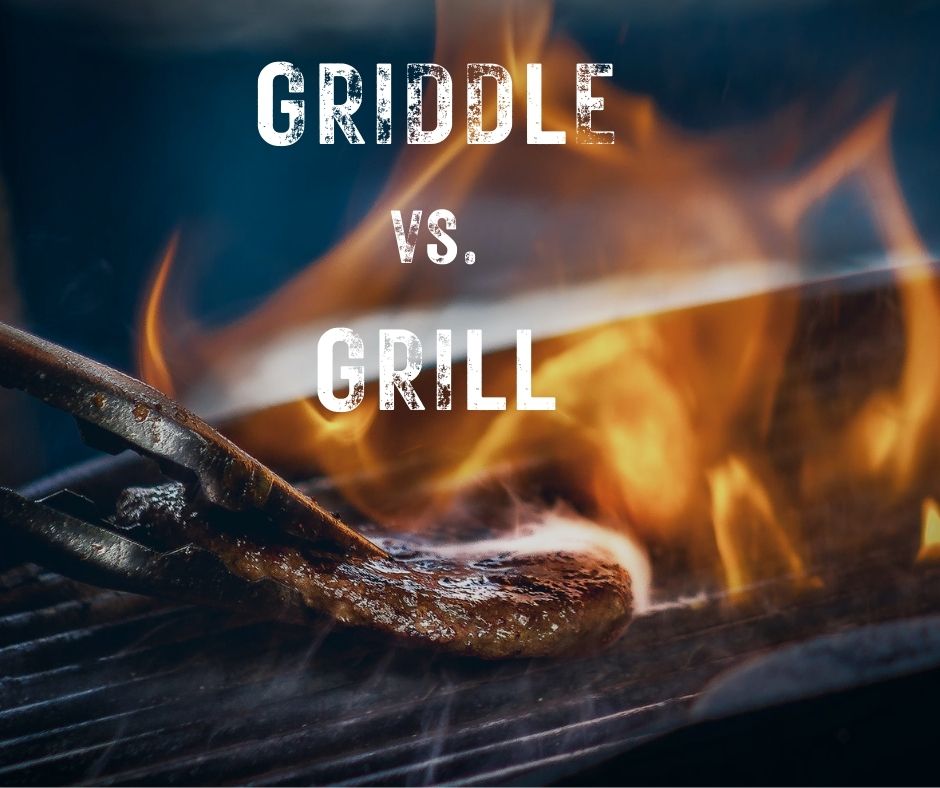Many people use the words griddle and grill interchangeably. But these two cooking surfaces are quite different. Griddles and grills use different cooking techniques, resulting in different tastes and appearances of the food.
They also differ in how heat contacts the food cooking upon them.
It is essential to know which one to use on what kind of food in order to get your desired outcome.
Let’s have a look at how griddles compare to grills and the types of food appropriate to each.
Griddle Vs. Grill
The main difference between a griddle and a grill is the cooking surface. A griddle is a smooth, flat metal cooking surface heated from underneath. The heat then spreads across the entire cooktop. A grill has a series of slated grates spread about half an inch apart over a heat source. It exposes food cooking upon it to an open flame.
What is a Griddle?
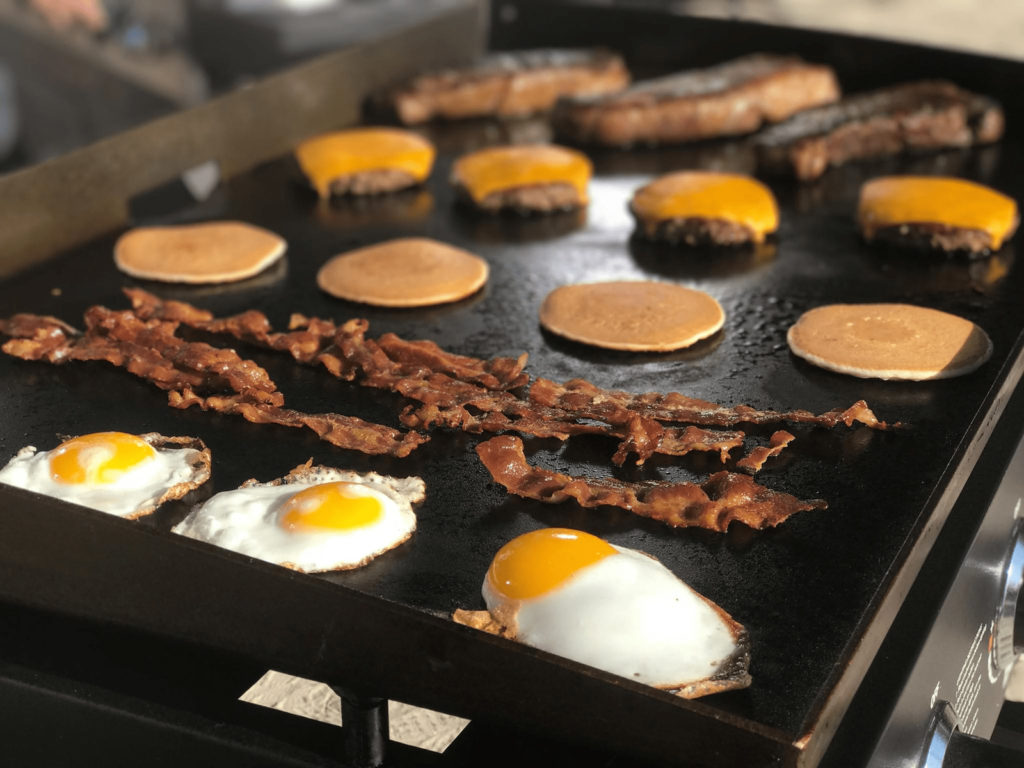
A griddle is a cooking device with a flat, smooth metal cooking surface that receives heat underneath. It is also known as a flat-top grill.
It resembles a big frying pan without a handle or sides, and food cooks directly on it.
Griddles are mostly rectangular. They come in different sizes depending on the intended use; home or commercial, indoor or outdoor.
Restaurant models are large, while home-based griddles can be small enough to fit between burners on a range top. Tabletop electric models are also small.
Griddles are either made of cold-rolled steel or stainless steel. Thicker metals provide better heat retention and excellent cooking quality. Thinner metals tend to warp with time, creating uneven cooking surfaces.
The one essential characteristic of a griddle that remains constant irrespective of size, model, or material used is that the cooktop is level.
Unlike grills, griddles do not have grates.
Types of Griddles
Below are the three main types of griddles available and their characteristics. The perfect choice for you will depend on your personal preferences.
Freestanding Griddles
As the name suggests, a freestanding griddle is independent. It comes attached to a stand and cart. Besides, it has sturdy and stable construction to allow it to stand/ operate without extra support.
A freestanding griddle is ideal for a big, flat cooking space in your backyard. It is perfect for indoor and outdoor use.
Most freestanding griddles are powered by propane, stored in portable tanks, and have multiple burners underneath the cooking surface. Some models are also convertible from propane to natural gas use from your house supply.
Some models have unique features like easy-to-clean grease traps, casters for effortless movement, and folding side tables to aid food preparation.
Blackstone has excellent freestanding griddles such as Blackstone Gas Griddle and Pit Boss 4 Burner Gas Griddle.
Tabletop Griddles
A tabletop griddle is similar to a hot plate. It is a small, lightweight, portable cooking surface that is easy to set and use.
If you are hosting a small barbecue party in your backyard or going camping or cookout, a tabletop griddle has you covered!
You can go with it anywhere and use it in the kitchen to prepare breakfast foods. This griddle will not clutter your cooking area and takes up very little space in your cupboard. Thanks to its compact size.
Tabletop griddles cook quickly and efficiently. For instance, the Blackstone Table Top 17-inch griddle uses a 1-lb propane bottle and produces 12,000 BTUs of cooking heat. It is reliable when making a light, quick meal.
Insert Griddles
An insert griddle is a square, flat cooking surface fitted over a fire pit or heating element to turn it into a griddle.
An insert griddle does not have heating surfaces underneath. This griddle comes in handy if you have a charcoal grill or gas BBQ and are not in a position to purchase a freestanding griddle.
This way, you will save money and make good use of the utilities you already have.
What Type of Food Do You Cook On a Griddle?
Griddles provide consistent heat across the flat-top cooking surface. They are ideal for cooking granular foods like fried rice and heavy liquids like eggs and pancakes.
Any food that you can’t cook on a grill or traditional BBQ, you can make on a griddle.
The versatility of a griddle allows you to cook different meals like:
Breakfast meals: These include eggs, pancakes, burger patties, bacon, hot dogs, and sausages. These dishes are best-prepared on a griddle because of their even, flat surface with no holes.
Dinner recipes: You can prepare all types of meat, chicken, fajitas, fried rice, and vegetables.
Pros of a Griddle
Versatility: You can cook just about anything from meat to breakfast delicacies to veggies on this flat-top grill.
Easy to clean: The smooth cooktop of a griddle is effortless to clean, mainly if it is well-seasoned and maintained.
Convenient for outdoor and indoor use: Griddles do not emit a lot of smoke since they don’t cook over an exposed flame. As a result, they are safer to use indoors, unlike grills. But be sure to confirm if your model is recommended for indoor use by the manufacturer.
Even searing: Griddles, especially stainless steel models, allow even heat distribution, resulting in a high-quality, uniform, consistent sear.
Healthy: Griddles promote healthy cooking because food is not exposed to the poisonous gases of an open flame.
Time-saving: The large cooktop of a griddle allows you to cook different meals simultaneously. Also, most griddles have heat zones, making it possible to simultaneously cook meals that require different temperatures.
Cons of a Griddle
High-quality griddles are pretty expensive.
Griddles need a lot of care. For instance, you must clean and season your griddle well after every use to prevent rusting. You must also use the correct oil. An oil with a very low smoke point risk ruining your food and damaging your griddle surface.
What is a Grill?
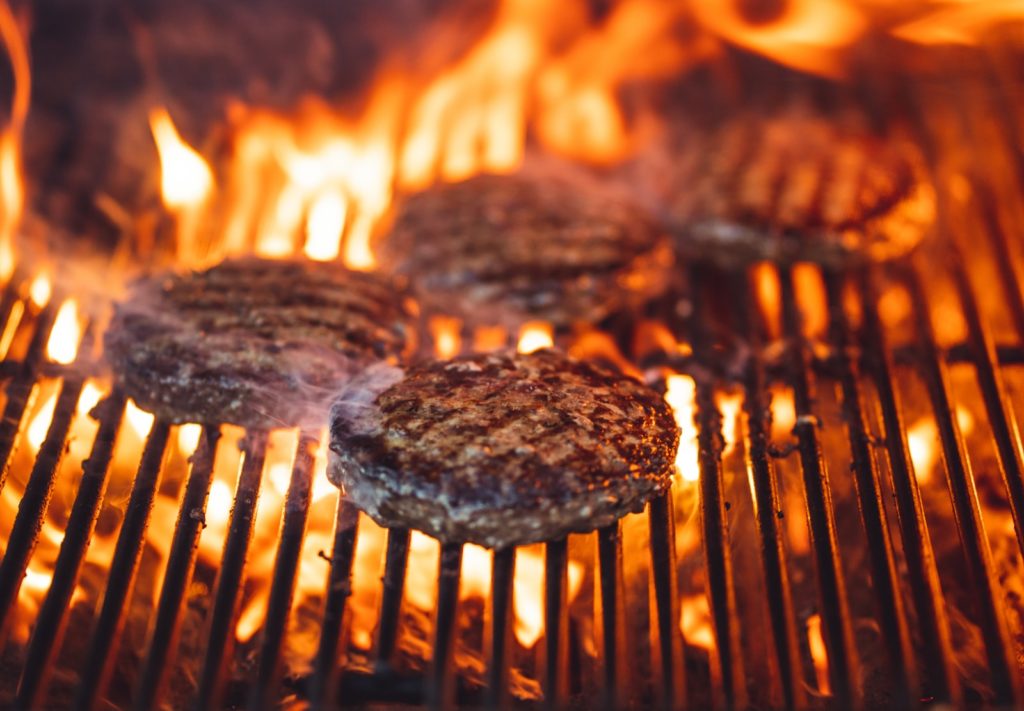
Unlike a griddle’s single, flat cooktop, a grill’s cooking surface has a series of slatted grates spread about a half-inch apart.
A grill has cast iron or stainless steel grates suspended above a heat source. The heat from the open flame helps to cook food directly, and the hot metal grates create the signature sear marks on the meat on contact.
Grills have three significant sources of heat; charcoal, wood pellets, and gas (propane or natural gas). Wood and charcoal grills are preferable because they impart a smoky flavor to the food.
Gas grills are more convenient as they light and cook faster but at the expense of some natural smoke flavor.
There are two types of grills, the open type with bars holding food directly over the open flame and the solid type with ridges.
Solid grills resemble griddles. They feature continuous rows of ridges through which grease drains away while creating beautiful sear marks on your meat.
Cheap grills have chromed steel metal grates, while high-end options have porcelain enameled steel or cast iron grills.
Grills produce a lot of smoke and heat. As such, they are ideal for outdoor use or underneath a commercial ventilation system.
What to Cook on a Grill
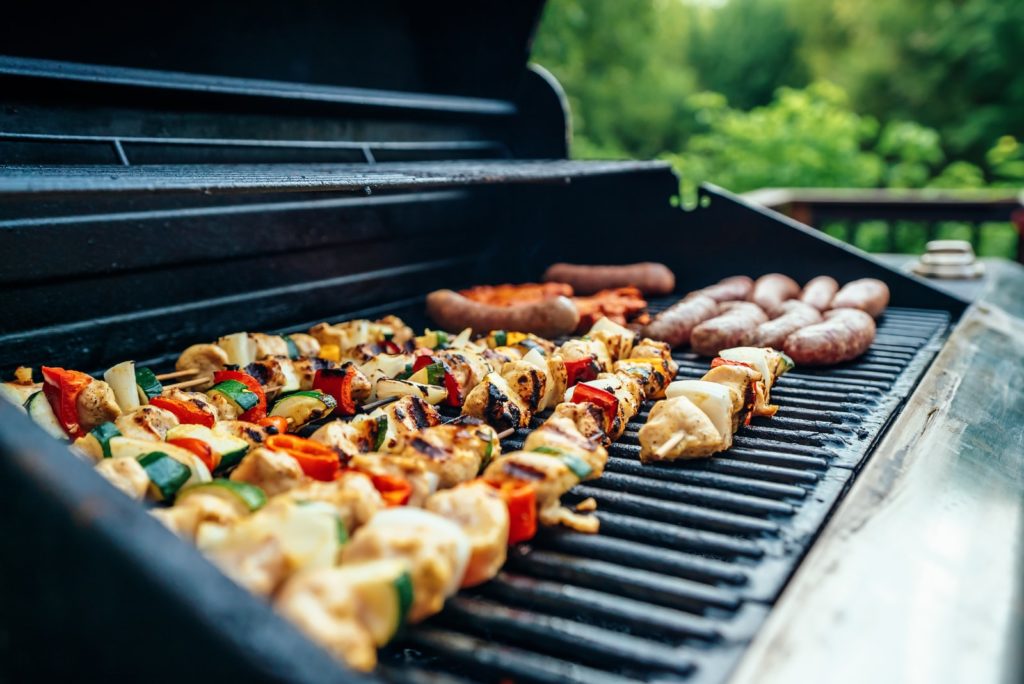
When using a grill, you must choose between direct and indirect grilling.
Direct grilling is intense, and it involves cooking your food directly above the heat source. It is perfect for foods like burgers, kebabs, thin steaks, whole fish, and other meals requiring high-temperature cooking.
Indirect grilling is gentler, and food cooks over a solid grill. It is ideal for bone-in chicken, thick pieces of steaks, and other foods that require low-temperature cooking.
Pros of a Grill
Easy to use: Gas grills are super-easy to fire up and use. They are perfect for a quick, tasty meal.
A grill creates beautiful checkered sear marks on your food.
Cooking on a grill adds some smoky flavor to your food
Cons of a Grill
Not suitable for indoor use: Grills produce a lot of smoke, and this will fill up your house in no time when used indoors.
Deep cleaning a grill is a nightmare: You need to deep clean your grill at least once every 6 months. The process is a bit complicated and tedious.
Not so healthy: Food cooked on an open flame absorbs a lot of poisonous gases, which can result in cancers and other health complications.
Griddle vs. Grill – A Detailed Comparison
Let me now put a griddle and a grill side by side to help you make an informed decision.
I will compare both of them on various attributes that are crucial. It will be easy for you to choose between them with this comparison.
Food Taste
Food taste is among the factors that differentiate a grill from a griddle. Here’s how:
Grills
As you cook with a grill, you will notice that it produces a fair amount of smoke. More often, part of this smoke gets absorbed into your food.
Thanks to this smoke, your food is likely to have a smokey flavor or taste. This taste may be a pro or a con, depending on whether your taste buds will love it or not.
Griddles
Food cooked on a griddle will mostly have a sautéed or pan-seared taste.
Moreover, griddles provide a wide cooking area that comes into contact with whatever you are cooking. As such, food prepared using a griddle will have a crispy layer on the outside.
Footprint
When I talk of footprint, I’m referring to the overall assemblage of either a grill or a griddle.
How much space do you have in your house or patio? The amount of space available will largely determine what you buy.
Grills
Grills are more challenging to assemble than griddles. The difficulty is thanks to their different separate parts, such as:
- Grates
- A cover
- A lid
- Legs
- A stand
These parts make grills not only bulky but also quite heavy.
Griddles
I would say that griddles are relatively compact; hence, they are more efficient in using space than grills.
Most griddles come already assembled. Moreover, some have built-in wheels that make them portable.
Cost
Price is an essential factor in determining whether to buy a product or not. However, I do not advocate that you only consider the price for you to make a decision.
Grills
Grills are less costly than griddles. However, this depends on factors such as the brand, type, materials, and type.
That said, it’s still possible to get an excellent functional grill at an entry-level price.
Griddle
A griddle is relatively expensive. Some entry-level models may not be that costly; however, you may have to dig deeper into your pocket for some high-end griddles.
Having said that, you can still get good griddles at an intermediate price.
Versatility
Both grills and griddles have a wide range of uses in cooking.
The bottom line is that you can use a griddle for cooking anything that you can cook on a grill. However, the reverse is not true.
For example, trying to cook eggs or pancakes on the grill grates will be almost impractical.
We love making steaks using a grill because it comes out with an added smoke flavor. Similarly, it’s also easy to cook steaks using a griddle, although you won’t get the smoke flavor.
A griddle will do a better job cooking foods that begin in soft forms, such as bacon, pancakes, and meat.
A griddle is also ideal for foods that you can cook in a frying pan. You can also cook all greasy foods using your griddle since it can hold the fat.
Again, a griddle is ideal for food meant for fun and larger meals.
On the other hand, a grill will be ideal for foods such as:
- Hot dogs
- Vegetables
- Cut off meats that may require a bit of searing
Safety
The amount of risk presented by griddles and grills is almost the same. The risk is thanks to the high temperatures these two use while cooking.
As such, you must observe high precautionary measures when using either.
However, one thing that sets griddles apart is the huge barrier between the food and the heat. This barrier acts as a protection for the chef in case of sudden fire flare-ups.
So, if we are to distinguish the two in terms of safety, I would say that a griddle is safer than a grill.
Maintenance and Cleaning
The ease of cleaning any product is a crucial factor that you cannot ignore. Whether you buy a griddle or a grill, it’s essential to know which is easy to clean.
Grill
A grill calls for much use of a scrubbing brush if you are to get rid of the stubborn bits of food. Furthermore, getting to the nooks and crannies will require more attention.
If grease gets into the grates, you will also have to remove them and clean them underneath.
Griddle
The flat surface makes the cleaning of a griddle relatively easy. Some warm water and sometimes soap may be all you will need to clean it.
Again, getting rid of stuck or unyielding bits of food is not a significant problem.
In summary, cleaning a griddle is far more straightforward than cleaning a grill.
Remember that you will also need to season a new griddle before using it. Seasoning is essential because:
- It coats the cooking surface and protects it against rust, damage by water and humidity
- It makes the cooking surface non-stick, thus making your cooking more effective
- It makes the cooking surface easy to clean
- It makes the griddle more durable
Again, you will need to re-season your griddle, especially if the surface begins to crack or blister.
All the same, both cleaning and seasoning a griddle are easy processes to do.
Materials
The material that makes a product is among the most important factors to consider. The material determines the durability and the safety of a product, among other factors.
Griddle
Most griddles in the market are of either steel or cast iron. These two are commonly made for home or personal use.
However, you may find other more significant designs of stainless steel or chrome. Mostly, these are for commercial purposes.
The materials that make griddles are excellent in heat retention and recovery. They, therefore, help to make your cooking more effective.
Grills
The grates in grills are of different materials. Some of the common materials include:
- Aluminum
- Cast-iron
- Nickel-plated steel
- Stainless steel
- Porcelain-enameled
The porcelain coating is helpful when it comes to cooking. However, it does not contribute whatsoever to effective cooking.
Many grill grates are also anti-corrosive, solid, and durable.
Cooking Temperature
Another distinguishing factor between grills and griddles is the temperature. Here is what separates the two.
Grills
They have high temperatures and work best at 399°F ( 204°C). This temperature causes heat transmission through metal grates and results in the intensely browned strips on meat.
The high temperature is ideal for foods such as steak. It allows you to achieve a fast outside sear without overcooking the pink center.
Griddles
Griddles work best at 350°F (177°C). This temperature is more than enough for frying bacon and searing meat. It’s also sufficient to provide you with fully cooked food.
All you need to ensure is that the heat is evenly distributed on the cooking surface. This ensures that no part of your food remains raw when the rest gets sufficiently cooked.
Cooking Surface Sizes
Grills offer a decent amount of cooking surface. However, they are not as versatile as griddles for outdoor cooking. Their cooking surface is smaller.
On the other hand, griddles such as the Blackstone griddle offer a large cooking surface. Their surface is ideal for cooking meals for a bigger family.
You can cook different types of foods simultaneously, thanks to the large surface.
Frequently Asked Questions
Are steaks better on grill or griddle?
Steaks are better on grills than on a griddle. The smoke flavor that a grill adds to steaks makes them taste better. However, you can cook steaks on a griddle just as easily.
Is griddle the same as grill?
They have some similarities and some differences. The main difference is that griddles have a smooth flat surface. On the other hand, grills have raised edges. The main similarity is that both help us in grilling food.
Are burgers better on grill or griddle?
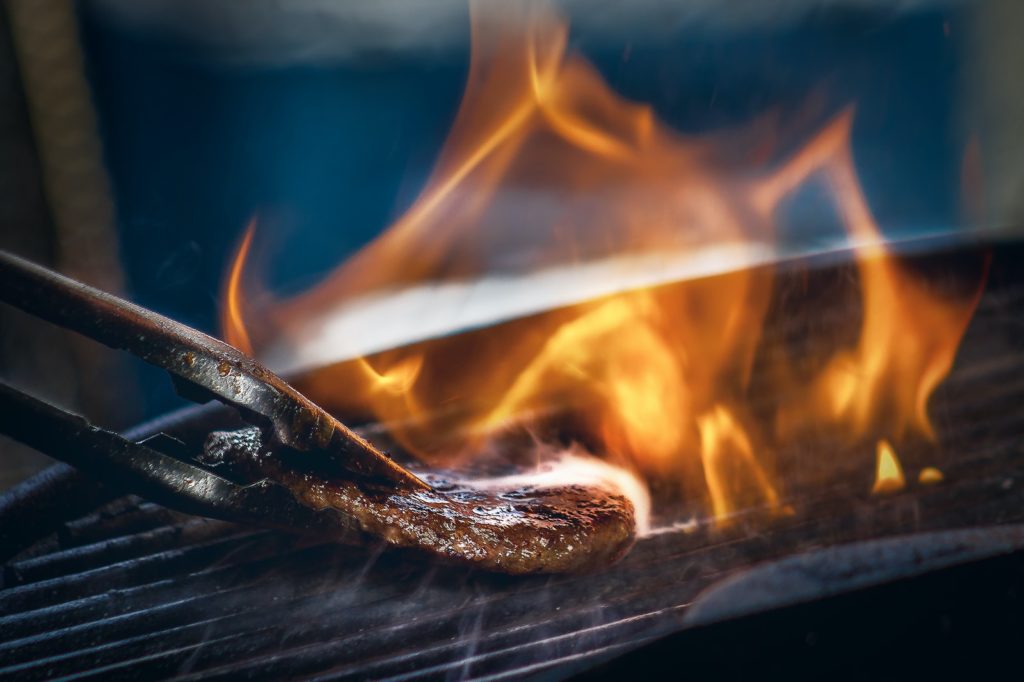
Burgers are better on a griddle than on a grill. A burger from a grill is, in most cases, dry because an amount of meat juices runs off into the grates. On the other hand, a griddle retains all the meat juice, thus producing a juicy and soft burger.
Is cooking on a griddle healthy?
Yes. Cooking on a griddle is healthy. A griddle ensures that your food does not come into contact with direct fire flames that may form harmful chemicals.
Wrapping it up
Griddles and grills have various similarities and differences. If you have been wondering which one to go for, I believe this article has given you great insights to help you decide.
Depending on your needs, you can choose which of the two best suits you. Consider their different factors in terms of materials, price, cooking surface, footprint, and food taste.
